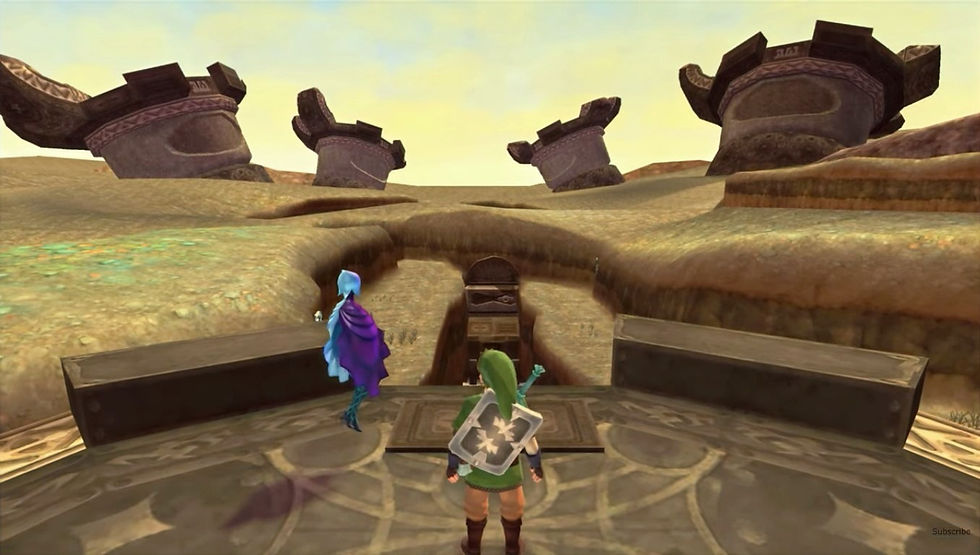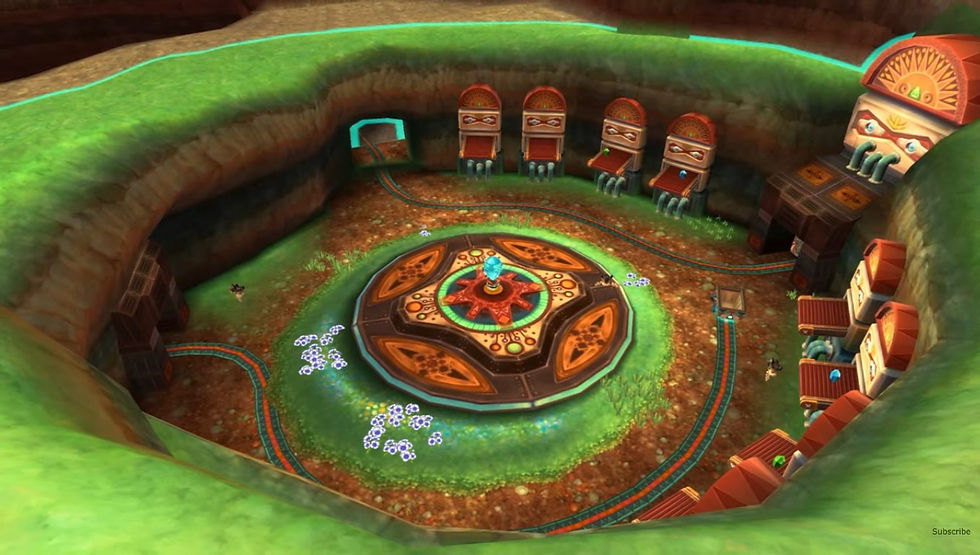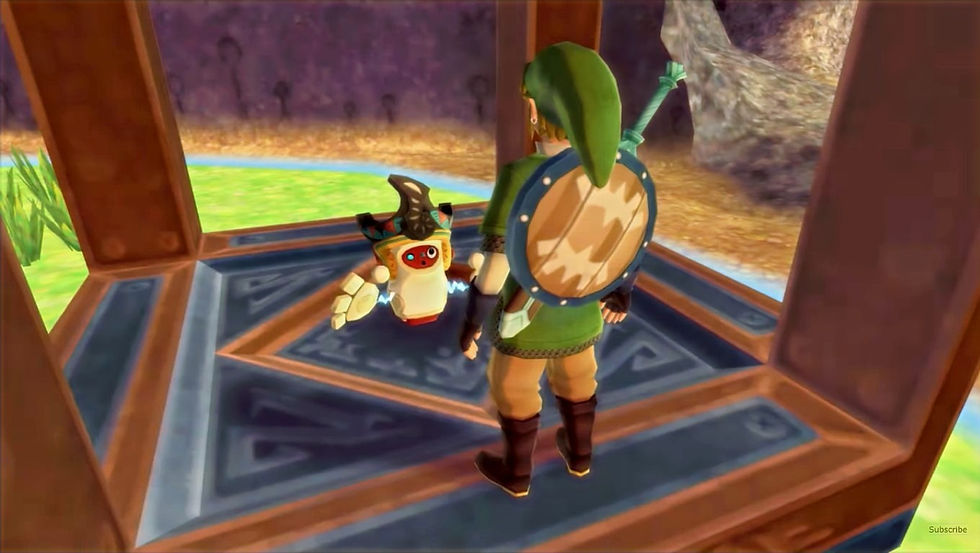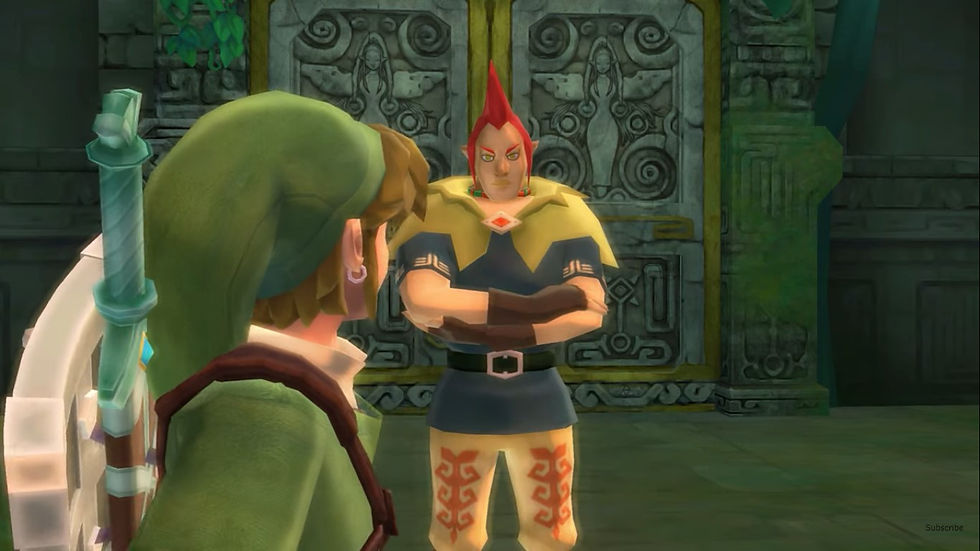Field Note #7: A Story of Green Fields & Dry Sand
- The Wolfess

- Jun 24, 2020
- 8 min read

Base Stats:
Game: Skyward Sword
Version: Original Wii Version, Physical Copy
System: Nintendo Wii U
Session Play Time: 2 hr 25 min
Total Play Time: 12 hrs 51 mins
Content Covered: Lanayru Mine, Lanayru Desert, Enter Lanayru Mining Facility
Fi Report: 7 Forced Interruptions
I have lived in all sorts of climates. From the warm summer rains that fall on the lushly forested Blue Ridge mountains to the dry, sagebrush-covered foothills of the temperate desert in the heart of the northern Rockies, I have learned to appreciate many different kinds of natural beauty. I now find myself living in a green plain that stretches from one horizon to the other. There are some big forests in the northeastern part of the state, but not down where I am. Long grass ripples in the wind like a wave in the ocean, a heron stands on the edge of a pond while some bird of prey circles overhead, and all around us insects buzz; everything is humming with the music of life. It is difficult to imagine this place covered in shifting sand dunes—but that is exactly what happened to Lanayru Desert in Skyward Sword. Its waters dried up, its trees bleached to white skeletons in the sand, and its grasses gave way to the endless shifting dust of the desert.
Before I get into the main discussion for this week’s Field Note, I want to touch base on accessibility for this game. Earlier in the week I found myself immobilized by a back injury. The littlest movements caused me intense pain. Although I received chiropractic care, I was still in a lot of pain when it came time to play through the next section of Skyward Sword. I found that it was incredibly difficult to play the game in a position that would not cause me pain. I had to be square on the sensor bar, sitting up, and within three feet or so for it to be able to tell what I was doing with the Wiimote. Although this issue has been fixed with the Switch, I have a new appreciation for how incredibly limiting the Wii platform was for people with physical limitations that affect their ability to meet its exact set up specifications. It was an eye-opening experience that I wanted to mention, and one of many reasons why Skyward Sword needs a Switch remake.
That point aside, let us return to Lanayru Province—home of a hot desert region populated by dead plants, electric-based enemies, and a whole lot of sand. It seems like a typical Zelda desert region as we descend from the sky. Once we touch down, we make our way into the remains of an old mine. There are still sections of rusty track, decrepit old mine carts, and unidentifiable hunks of machinery near the walls. Things change, however, when we find the central hub of this mine. It is a circular room with conveyor belts mounted on the walls which would deposit stone into the mine carts as they circle around the track system. Sitting on a rusty pedestal at the center of the room is a strange purplish-blue stone with an eye carved deep inside. The game makes a point of drawing our attention to this stone. Once we strike it with our sword, the most amazing thing happens.

The stone turns bright blue with a light from deep inside. This bright blue light spreads outward from it along the ground. As the stone begins to hover in the air, the dry mine is transformed under our feet into a lush, green oasis. The piles of machinery stand up, fix themselves, start to hum and beep and move about the room. Fi quickly pops up and confirms that the stone is called a timeshift stone. By activating it, we have transported ourselves into the distant past, long before this region became a desert. We find out that the machines are little robots powered by timeshift stones. They are assigned to mine this region for the raw timeshift stone material. Both the robots and the timeshift stones found throughout this region are key to the puzzles during this section of the game.

When we finally enter the main portion of the desert, Fi informs us that this region rapidly declined due to “climate forces” until it became the desert it is today. As I looked out over the arid landscape, I tried to imagine the place covefield-note-7-a-story-of-green-fields-dry-sandred in grass and bugs and birds. We later find out that there is a whole ocean which has dried up to sinking sand. I couldn’t help but wonder “what could have caused the climate here to change so drastically?” Was it human intervention, like many areas in our world today? Did the robots mine it to death, like the ‘dust bowl’ of the Great Depression? Or could something like this happen…naturally?

For answers I looked to the real world: the Sahara Desert. By researching things like core samples and ancient cave paintings, scientists have learned that the famous African desert used to be a green savannah. It had large rivers, grassy plains, wetlands, and even a huge lake in the middle larger than all three Unites States great lakes combined. It was also full of grass-loving wildlife. This period, called the African Humid Period, started about 14,000 years ago and ended between 11,000 to 5,000 years ago. By examining what happened to the green, lush Sahara region of Northern Africa, we might learn what happened to the Lanayru region in Skyward Sword.
Although some scientists believe that human influence, such as cattle and goat grazing, was the tipping point that pushed it over the edge in the end, it is generally agreed in the scientific community that the overall change was due to natural causes. As the Earth rotates around the sun, its axis “wobbles” ever so slightly. These changes in the tilt of the earth cause major changes in temperatures on the surface, causing some regions to warm up and others to cool. Looking at the core samples, there is evidence that Africa was heating up at the same time as North America was cooling down. What’s additionally interesting is that this wasn’t an isolated incident for the Sahara region. It’s just the latest in a long history of cycling between humid periods and dry periods based on the changing tilt of the earth. Theoretically, the Saharah Desert will have another humid period in the distant future. Check out this video from PBS for the whole story.
So what can this tell us about Lanayru? What happened here? From what we’ve learned, and from Fi’s assertion that the change happened due to ‘climate forces’, we can assume the wet grasslands of the region turned into sandy deserts naturally about 5 – 10,000 years ago. The time period we visit with the timeshift stones is likely between 9 – 11,000 years ago, when the land was starting to die. So that’s the answer, right? This was all natural, like the Sahara Desert. Case closed. But I don’t think that’s the whole story.

Based on some peculiar details, I do think something happened in Lanayru to speed up the process. Through the timeshift stones, we can see that 10,000 years ago the robots are in the exact spots where they were working. The robot in the cage dies there, as do his captors outside the cage. The factories and mine carts and rooms are all exactly where they were when we visit them and in roughly the same shapes. Most convincingly, the notices on the boards in the factories don’t change. In the one where we activate the fire power node, one notice says the following:
“The plants are drying out! Vrrt! Let’s keep Lanayru green! Zzt! -Shift Supervisor”
This is important because it confirms two things: one, that the time period we visit inside the factory is the same green time period as outside the factory (so, 9 – 11k years in the past). Two, that the factories were abandoned and overrun by monsters except for one robot in the way back left there to guard the power node. Some of those monsters are still alive and full grown today. In fact, this seems to be true of much of region. Monsters are everywhere, mining facilities are abandoned and still, and the robots are either cowering in fear or trying to stay safe away from the monsters. In fact, one robot tells us that the monsters are kidnapping robots and stealing their electricity—effectively killing them.

For a while I was still stumped. How could what’s going on with the robots affect the natural course of the region’s drying out? What is going on with the robots anyway? Then one crucial detail hit me: there are no hylians around. Not a single one. The robots talk all the time about taking care of the temple of time and what an important place that is (we’ll get to that oddity in a later article, I promise…), but there are no visitors to the region or to the temple. This complete absence gives us a point of reference for when in time we are: we must be sometime after the Goddess sent all the hylians into the sky for protection. I would even argue that it’s after the first sealing of the Demon King.
Think about it: a war is raging. All of the hylians are gone, having been sent to the sky by the Goddess. The sheikah, whose symbol is on that timeshift stone, are also nowhere to be seen—likely protecting the Goddess as she makes her fateful plans. The robots are left to keep going about their tasks as previously ordered, despite the loss in leadership. Having also lost the storage and processing factories, they have no way of refining the stone to a usable power source. As such, they keep mining until they lose power entirely and drop where they stand.
The Demon King’s forces are doing the same thing. They started invading the region as commanded, but the Demon King is sealed and new orders never come. Faithful to their master, the monsters stay exactly where they were. The bokoblins die at their posts waiting to be told what to do next. The sudden event that was the “tipping point” for the Lanayru region was the great clash between the Goddess and the Demon King. This remote place is forgotten in the aftermath and left uncared for—by both sides of the war—and it faded away into the sand dunes.
Since this is the first game in the Zelda Timeline, we know that this region never bounces back. It stays a desert for ages to come—although its name and inhabitants eventually change. The Saharah Desert, too, may never go through another humid period. In the past, climate change happened because the Earth’s axis changed its tilt. Cold and hot spots merely shifted around. Human-induced global warming, however, is causing the whole planet to warm up at an exponential rate. No region is growing colder because the Sahara is getting hotter. The truth is that drastic measures need to be taken to stop carbon emissions and repair the damage we’ve done to our planet, or the Sahara may end up just like Lanayru: forgotten, abandoned, and unlivable.

Want to help the Sahara Desert have the possibility of another humid period in the future? Wondering how you can get involved in the fight against global warming? There are many resources for education and involvement both online and locally. Nasa and National Geographic are two options for education about the issue, and the Environmental Defense Fund is just one of many organizations you can donate to in order to fund the fight. Most importantly, look into the little ways you can change your lifestyle in order to reduce your carbon footprint. Together, as the robot shift supervisor would say, we can “keep our planet green! Zzt!”
So, what do you think about how the Lanayru region dried out? What are your thoughts on the Sahara Desert’s Humid Period and its dubious future? Most importantly, how will you be a force for positive change for the planet? Sound off in the comments, and I will see you next week.




Comments